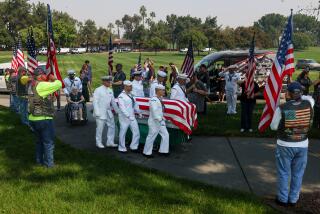Long-Missing Flier’s Family Heartened by Small Victory
- Share via
It was a small victory in the POW-MIA saga, but nonetheless significant in a family quest to determine the fate of Lt. Col. John Leighton Robertson, an Air Force fighter pilot shot down over North Vietnam in September, 1966.
Two years ago, the government closed Robertson’s MIA case under the presumption that he was killed. Last week, amid special U.S. Senate hearings into whether there are any American prisoners of war still in Vietnam, the Defense Department decided to retract its conclusion in the Robertson matter and return his name to a list of 119 so-called “discrepancy cases” under active investigation.
In POW-MIA parlance, discrepancy cases involve, among other service personnel, missing fliers who were believed to be alive on the ground immediately after their aircraft had crashed. The federal government now wants to clear up these cases as a prelude to normalizing U.S. relations with Vietnam.
“The fact that he was alive on the ground was news to me,” said Shelby Robertson Quast, Robertson’s youngest daughter. “It was the first time our family had learned that the government knew he had ejected safely. They had closed the case two years ago. It is now an active discrepancy case again.”
In July of this year, a grainy photograph surfaced that purportedly shows Lt. Col. Robertson, Navy Lt. Larry James Stevens and Air Force Maj. Albro Lyn Lundy standing in civilian garb and holding what appears to be a sign with dates and a cryptic message.
Family members, including Robertson’s wife, Barbara, of Santa Ana, identified all three men as their relatives. But Defense Department officials have questioned the picture’s authenticity and whether it has been doctored like other proven hoaxes involving MIAs. They say that as many as five families have come forward to identify the men described as Lundy and Stevens. So far, no conclusions have been reached regarding the photo’s validity.
After 25 years of silence and false leads, the photograph was Barbara Robertson’s first significant clue in trying to determine what happened to her husband, who was 36 years old when his F-4C Phantom jet was lost during a dogfight.
Since the picture was discovered, family members said they have had to go to unusual lengths to get the case reopened. One daughter spent 10 days in Southeast Asia, while another testified before the Senate Select Committee on MIA-POW Affairs, which was convened after the public disclosure of several photos, including the Robertson-Stevens-Lundy picture.
In October, Deborah Robertson Bardsley of Chatsworth, under the escort of Vietnamese officials, visited the site where her father’s plane crashed and a nearby village, where she was shown a closet containing small pieces of wreckage. While the site has not been excavated, no human remains have been recovered from the crater, now overgrown with jungle foliage, or the surrounding area.
“It seemed like the villagers we talked to had been coached,”Bardsley said. “They said my father died in the crash, and they recalled things in absolute clarity that happened 25 years ago. They all seemed to use the exact same words.”
Bardsley said, however, that during a break in the questioning, a villager in his 60s quietly approached and told her something incredible--he had helped to capture an American pilot with “bright” or blond hair. Bardsley said she then pulled a picture of her father out of her pocket.
“He said, ‘Yes, it looks like him.’ It was the most spontaneous moment I had all day,” she recalled. “It made me very nervous because I never expected to hear anything like this.”
Bardsley said members of her entourage soon broke up their conversation. Her interpreter, she said, demanded repeatedly that she give up the picture while other officials surrounded the elderly man and apparently gave him a warning. She refused to turn over the photograph.
Bardsley also said she talked to another Vietnamese who had helped capture her father’s bombardier-navigator, Lt. Hugh Buchanan. He survived the war and was released from a POW camp in 1973.
What happened during Bardsley’s 10-day visit was told to the special Senate committee last week by her sister Shelby Quast, whose five-minute talk outlined the reasons why her father’s case should be reopened. Bardsley was at her side.
Quast, of Virginia, cited the discussions with villagers, noted live-sighting reports and made it clear that the purported photograph of her father and the two other men was not lifted from a Soviet magazine, as were other so-called POW pictures.
“We feel that they took a hard look at all the evidence and concluded there was no way they could rationally close the case,” Barbara Robertson said. “But it has been a year of utter frustration, and we feel the government has not been entirely honest with us.”
During the hearings, the daughters said they learned that their father’s disappearance had been handled as a discrepancy case, an indication the Defense Department had evidence suggesting that Robertson was alive after his plane went down.
Yet, amid the controversy, conflicting evidence and constant rumors of live Americans, many Pentagon officials have stated that they have no reason to believe that any missing servicemen remain as prisoners of war in Southeast Asia.
“I hope in the end we reach the truth,” Quast said. “Unfortunately, we are a long way from it right now.”
More to Read
Sign up for Essential California
The most important California stories and recommendations in your inbox every morning.
You may occasionally receive promotional content from the Los Angeles Times.














